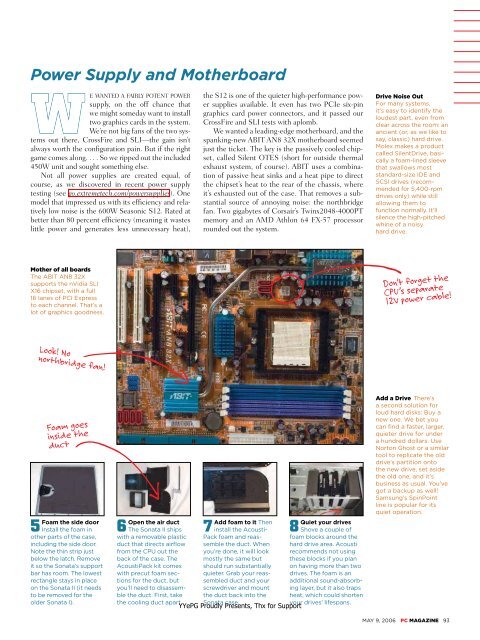Unauthorized - Parent Directory - Support
Unauthorized - Parent Directory - Support
Unauthorized - Parent Directory - Support
Create successful ePaper yourself
Turn your PDF publications into a flip-book with our unique Google optimized e-Paper software.
Power Supply and Motherboard<br />
WE WANTED A FAIRLY POTENT POWER<br />
supply, on the off chance that<br />
we might someday want to install<br />
two graphics cards in the system.<br />
We’re not big fans of the two systems<br />
out there, CrossFire and SLI—the gain isn’t<br />
always worth the configuration pain. But if the right<br />
game comes along. . . . So we ripped out the included<br />
450W unit and sought something else.<br />
Not all power supplies are created equal, of<br />
course, as we discovered in recent power supply<br />
testing (see go.extremetech.com/powersupplies). One<br />
model that impressed us with its efficiency and relatively<br />
low noise is the 600W Seasonic S12. Rated at<br />
better than 80 percent efficiency (meaning it wastes<br />
little power and generates less unnecessary heat),<br />
the S12 is one of the quieter high-performance power<br />
supplies available. It even has two PCIe six-pin<br />
graphics card power connectors, and it passed our<br />
CrossFire and SLI tests with aplomb.<br />
We wanted a leading-edge motherboard, and the<br />
spanking-new ABIT AN8 32X motherboard seemed<br />
just the ticket. The key is the passively cooled chipset,<br />
called Silent OTES (short for outside thermal<br />
exhaust system, of course). ABIT uses a combination<br />
of passive heat sinks and a heat pipe to direct<br />
the chipset’s heat to the rear of the chassis, where<br />
it’s exhausted out of the case. That removes a substantial<br />
source of annoying noise: the northbridge<br />
fan. Two gigabytes of Corsair’s Twinx2048-4000PT<br />
memory and an AMD Athlon 64 FX-57 processor<br />
rounded out the system.<br />
Drive Noise Out<br />
For many systems,<br />
it’s easy to identify the<br />
loudest part, even from<br />
clear across the room: an<br />
ancient (or, as we like to<br />
say, classic) hard drive.<br />
Molex makes a product<br />
called SilentDrive, basically<br />
a foam-lined sleeve<br />
that swallows most<br />
standard-size IDE and<br />
SCSI drives (recommended<br />
for 5,400-rpm<br />
drives only) while still<br />
allowing them to<br />
function normally. It’ll<br />
silence the high-pitched<br />
whine of a noisy<br />
hard drive.<br />
Mother of all boards<br />
The ABIT AN8 32X<br />
supports the nVidia SLI<br />
X16 chipset, with a full<br />
16 lanes of PCI Express<br />
to each channel. That’s a<br />
lot of graphics goodness.<br />
Don’t forget the<br />
CPU’s separate<br />
12V power cable!<br />
Look! No<br />
northbridge fan!<br />
Foam goes<br />
inside the<br />
duct<br />
Foam the side door<br />
5 Install the foam in<br />
other parts of the case,<br />
including the side door.<br />
Note the thin strip just<br />
below the latch. Remove<br />
it so the Sonata’s support<br />
bar has room. The lowest<br />
rectangle stays in place<br />
on the Sonata II (it needs<br />
to be removed for the<br />
older Sonata I).<br />
Open the air duct<br />
6 The Sonata II ships<br />
with a removable plastic<br />
duct that directs airflow<br />
from the CPU out the<br />
back of the case. The<br />
AcoustiPack kit comes<br />
with precut foam sections<br />
for the duct, but<br />
you’ll need to disassemble<br />
the duct. First, take<br />
the cooling duct apart.<br />
Add foam to it Then<br />
7 install the Acousti-<br />
Pack foam and reassemble<br />
the duct. When<br />
you’re done, it will look<br />
mostly the same but<br />
should run substantially<br />
quieter. Grab your reassembled<br />
duct and your<br />
screwdriver and mount<br />
the duct back into the<br />
Sonata case.<br />
YYePG Proudly Presents, Thx for <strong>Support</strong><br />
Quiet your drives<br />
8 Shove a couple of<br />
foam blocks around the<br />
hard drive area. Acousti<br />
recommends not using<br />
these blocks if you plan<br />
on having more than two<br />
drives. The foam is an<br />
addi tional sound-absorbing<br />
layer, but it also traps<br />
heat, which could shorten<br />
your drives’ lifespans .<br />
Add a Drive There’s<br />
a second solution for<br />
loud hard disks: Buy a<br />
new one. We bet you<br />
can find a faster, larger,<br />
quieter drive for under<br />
a hundred dollars. Use<br />
Norton Ghost or a similar<br />
tool to replicate the old<br />
drive’s partition onto<br />
the new drive, set aside<br />
the old one, and it’s<br />
business as usual. You’ve<br />
got a backup as well!<br />
Samsung’s SpinPoint<br />
line is popular for its<br />
quiet operation.<br />
MAY 9, 2006 PC MAGAZINE 93


